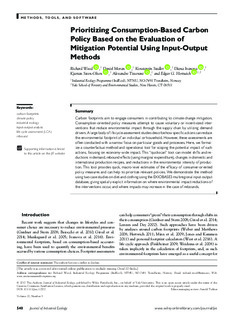| dc.contributor.author | Wood, Richard | |
| dc.contributor.author | Moran, Daniel | |
| dc.contributor.author | Stadler, Konstantin | |
| dc.contributor.author | Ivanova, Diana | |
| dc.contributor.author | Steen-Olsen, Kjartan | |
| dc.contributor.author | Tisserant, Alexandre | |
| dc.contributor.author | Hertwich, Edgar G. | |
| dc.date.accessioned | 2019-02-19T10:15:13Z | |
| dc.date.available | 2019-02-19T10:15:13Z | |
| dc.date.created | 2017-11-30T12:03:13Z | |
| dc.date.issued | 2018 | |
| dc.identifier.citation | Journal of Industrial Ecology. 2018, 22 (3), 540-552. | nb_NO |
| dc.identifier.issn | 1088-1980 | |
| dc.identifier.uri | http://hdl.handle.net/11250/2586169 | |
| dc.description.abstract | Carbon footprints aim to engage consumers in contributing to climate‐change mitigation. Consumption‐oriented policy measures attempt to cause voluntary or incentivized interventions that reduce environmental impact through the supply chain by utilizing demand drivers. A large body of life cycle assessment studies describe how specific actions can reduce the environmental footprint of an individual or household. However, these assessments are often conducted with a narrow focus on particular goods and processes. Here, we formalize a counterfactual method and operational tool for scoping the potential impact of such actions, focusing on economy‐wide impact. This “quickscan” tool can model shifts and reductions in demand, rebound effects (using marginal expenditure), changes in domestic and international production recipes, and reductions in the environmental intensity of production. This tool provides quick, macro‐level estimates of the efficacy of consumer‐oriented policy measures and can help to prioritize relevant policies. We demonstrate the method using two case studies on diet and clothing using the EXIOBASE3 multiregional input‐output database, giving spatially explicit information on where environmental impact reductions of the interventions occur, and where impacts may increase in the case of rebounds. | nb_NO |
| dc.language.iso | eng | nb_NO |
| dc.publisher | Wiley | nb_NO |
| dc.relation.uri | https://onlinelibrary.wiley.com/doi/full/10.1111/jiec.12702 | |
| dc.rights | Navngivelse 4.0 Internasjonal | * |
| dc.rights.uri | http://creativecommons.org/licenses/by/4.0/deed.no | * |
| dc.title | Prioritizing Consumption-Based Carbon Policy Based on the Evaluation of Mitigation Potential Using Input-Output Methods | nb_NO |
| dc.title.alternative | Prioritizing Consumption-Based Carbon Policy Based on the Evaluation of Mitigation Potential Using Input-Output Methods | nb_NO |
| dc.type | Journal article | nb_NO |
| dc.type | Peer reviewed | nb_NO |
| dc.description.version | publishedVersion | nb_NO |
| dc.source.pagenumber | 540-552 | nb_NO |
| dc.source.volume | 22 | nb_NO |
| dc.source.journal | Journal of Industrial Ecology | nb_NO |
| dc.source.issue | 3 | nb_NO |
| dc.identifier.doi | 10.1111/jiec.12702 | |
| dc.identifier.cristin | 1520819 | |
| dc.description.localcode | © 2017 The Authors. Journal of Industrial Ecology, published by Wiley Periodicals, Inc., on behalf of Yale University. This is an open access article under the terms of the Creative Commons Attribution License. | nb_NO |
| cristin.unitcode | 194,64,25,0 | |
| cristin.unitname | Institutt for energi- og prosessteknikk | |
| cristin.ispublished | true | |
| cristin.fulltext | preprint | |
| cristin.qualitycode | 2 | |

